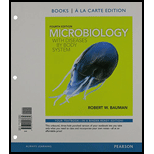
Concept explainers
Introduction:
The recombinant DNA technology involves isolation of genetic materials (DNA) from donor organisms (human, plant, or microorganism) and inserts them to recipient organisms after genetic manipulation. The main tools involved in the techniques are
Want to see the full answer?
Check out a sample textbook solution
Chapter 8 Solutions
Microbiology with Diseases by Body System, Books a la Carte Edition & Modified Mastering Microbiology with Pearson eText -- ValuePack Access Card
- The activity of restriction enzymes may produce fragments with sticky ends. Sticky ends are a) a type of endonucleases. b) dephosphorylated CpG islands. c) unpaired nucleotides. d) double breaks with blunt ends.arrow_forwardUsing the data in Table, identify restriction enzymes that (a) produce blunt ends; (b) recognize and cleave the same sequence (called isoschizomers); (c) produce identical sticky ends.arrow_forwardWhich of the following is FALSE about current Sanger dideoxy DNA sequencing procedures? a. Chain termination occurs during synthesis of a new DNA strand. b. Many steps can be automated. c. No DNA is synthesized in the procedure. d. Fluorescent molecules can be used to detect the DNA.arrow_forward
- The restriction endonucleases used in recombinant DNA work: a. are synthesized by bacteria b. recognize sequences 14-16 bp long c. cut the DNA outside the recognition sequence d. all the above are truearrow_forwardChoose the one answer that fits best. Which statement regarding Molecular Biology is NOT correct (videos)? a. Taq Polymerase was isolated from an organism found in Yellowstone Park b. Restriction enzymes leave sticky ends c. DNA sequencing allows us to read DNA sequences d. Restriction enzymes cut DNA at specific sites e. EcoRI and HindII are commonly used polymerasesarrow_forwardA DNA fingerprint is based on _____. a repeating sequences found on noncoding regions b the presence of restriction enzymes c a single repeating region d repeating sequences found on coding regionsarrow_forward
- Shotgun sequencing is a method of DNA sequencing in whicha. the DNA fragments to be sequenced are randomly generatedfrom larger DNA fragments.b. the sequencing reactions are carried out in rapidsuccession.c. the samples to be sequenced are rapidly generatedby PCR.d. all of the above occur.arrow_forwardin Cohen-Boyer's recombinant DNA procedure _______ must be used for both the bacterial DNA and the amphibian DNA _______. a. the same restrictions enzyme, so that the the restriction site are identical in the DNA of each species b. different restriction enzymes, so that the genes outside the restriction site are maintained c. the same restriction enzymes, to ensure that the newly formed DNA can replicate d. different restriction enzymes, to ensure that the newly introducted genes are maintained in the bacterial DNAarrow_forwardWhich type of cells were used to extract the DNA that was sequenced? a. red blood cells c. white blood cells b. intestinal epithelium d. cheek swab What type of mutation caused Nicholas’s disease? a. frameshift c. nonsense b. missense d. insertionarrow_forward
- Place the steps of sanger sequencing in order.A. A fluorescent laser excites the fragments and records the wavelength consistent with a single nucleotide. B. ddNTPs bind and stop chain extension.C. DNA fragments are separated by size through a capillary tube. D. DNA polymerase copies the target region of template DNA.E. The final nucleotide of each fragment is labeled with a fluorescent tag.arrow_forwardPut the following tasks in the order they would occur during a DNA cloning experiment. a. using DNA ligase to seal DNA fragments into vectors b. using a probe to identify a clone in the library c. sequencing the DNA of the clone d. making a DNA library of clones e. cutting genomic DNA with restriction enzymesarrow_forwardWhich of the following is true? a. In one technique, the DNA sequence can be determined using one strand of DNA as it passes through a nanopore. b. Next generation sequencing is slow but accurate. c. Both of the above are true.arrow_forward
